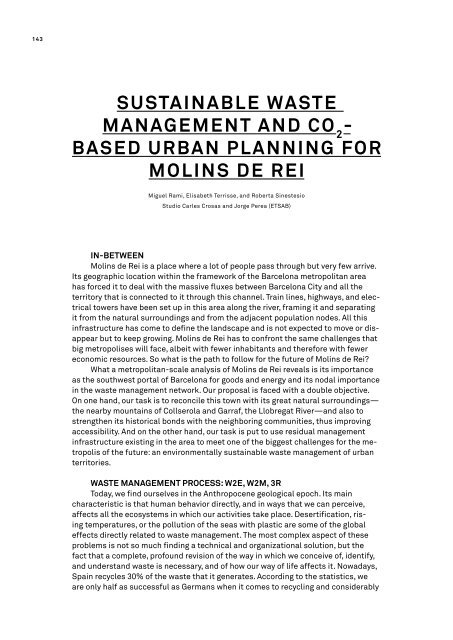DESIGNING TERRITORIAL METABOLISM
978-3-86859-489-8 https://www.jovis.de/de/buecher/product/designing_territorial_metabolism.html
978-3-86859-489-8
https://www.jovis.de/de/buecher/product/designing_territorial_metabolism.html
You also want an ePaper? Increase the reach of your titles
YUMPU automatically turns print PDFs into web optimized ePapers that Google loves.
143<br />
SUSTAINABLE WASTE<br />
MANAGEMENT AND CO 2<br />
-<br />
BASED URBAN PLANNING FOR<br />
MOLINS DE REI<br />
Miguel Rami, Elisabeth Terrisse, and Roberta Sinestesio<br />
Studio Carles Crosas and Jorge Perea (ETSAB)<br />
IN-BETWEEN<br />
Molins de Rei is a place where a lot of people pass through but very few arrive.<br />
Its geographic location within the framework of the Barcelona metropolitan area<br />
has forced it to deal with the massive fluxes between Barcelona City and all the<br />
territory that is connected to it through this channel. Train lines, highways, and electrical<br />
towers have been set up in this area along the river, framing it and separating<br />
it from the natural surroundings and from the adjacent population nodes. All this<br />
infrastructure has come to define the landscape and is not expected to move or disappear<br />
but to keep growing. Molins de Rei has to confront the same challenges that<br />
big metropolises will face, albeit with fewer inhabitants and therefore with fewer<br />
economic resources. So what is the path to follow for the future of Molins de Rei?<br />
What a metropolitan-scale analysis of Molins de Rei reveals is its importance<br />
as the southwest portal of Barcelona for goods and energy and its nodal importance<br />
in the waste management network. Our proposal is faced with a double objective.<br />
On one hand, our task is to reconcile this town with its great natural surroundings—<br />
the nearby mountains of Collserola and Garraf, the Llobregat River—and also to<br />
strengthen its historical bonds with the neighboring communities, thus improving<br />
accessibility. And on the other hand, our task is put to use residual management<br />
infrastructure existing in the area to meet one of the biggest challenges for the metropolis<br />
of the future: an environmentally sustainable waste management of urban<br />
territories.<br />
WASTE MANAGEMENT PROCESS: W2E, W2M, 3R<br />
Today, we find ourselves in the Anthropocene geological epoch. Its main<br />
characteristic is that human behavior directly, and in ways that we can perceive,<br />
affects all the ecosystems in which our activities take place. Desertification, rising<br />
temperatures, or the pollution of the seas with plastic are some of the global<br />
effects directly related to waste management. The most complex aspect of these<br />
problems is not so much finding a technical and organizational solution, but the<br />
fact that a complete, profound revision of the way in which we conceive of, identify,<br />
and understand waste is necessary, and of how our way of life affects it. Nowadays,<br />
Spain recycles 30% of the waste that it generates. According to the statistics, we<br />
are only half as successful as Germans when it comes to recycling and considerably


















